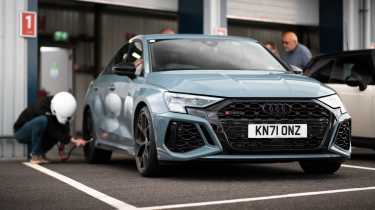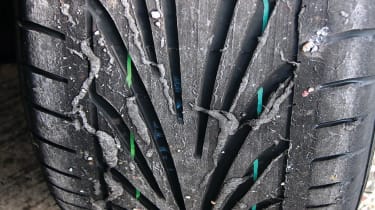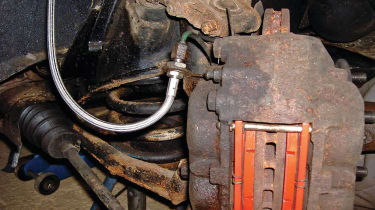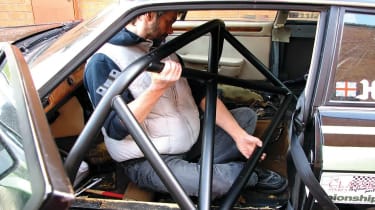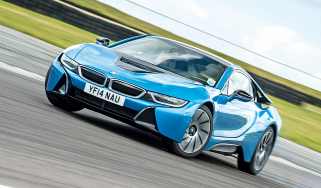How to prepare your car for a track day
Preparation is key for both performance and safety on the circuit. Here's our comprehensive checklist
Thinking about optimising your car for track days? There are plenty of ways to go about it, and it needn’t cost a fortune. In fact there are modifications to suit any budget, and you might even like to get stuck in yourself. Read on to see preparations you can make to your car for a successful track day. With each round of improvements and revisions made, you can up the ante from the basic essential track day preparations to full-bore track day modifications. Below we have broken down the track day preparations you can make and the order in which we think they should be carried out.
> evo Trackdays 2022: dates, tickets, booking info
Step 1: Essential preparation
Of course you don’t have to spend a fortune on modifications to run your car round a track – many cars have more than enough performance straight out of the box – but the fact that it will spend much of the day flat-out means that there are a few essential jobs to do to stop it melting or falling apart.
Service/oil
The first piece of preparation work is a thorough service, including gearbox, differential, brakes and the cooling system, using fluids more tuned to harsh use (for example, Castrol Edge engine oil).
Depending on the car it may be best to run the oil level towards the low mark on the dipstick to prevent ‘pull over’ (where oil gets into the inlet manifold at high revs), or towards the top end if the engine is prone to surge (where the oil in the sump sloshes away from the pick-up pipe). Find out from a specialist or look on an owners’ club forum. Either way, check the level after each run, as consumption will be higher than in normal road use.
Inspection
Every critical component should be inspected, because even on modern cars bolts and clips can become loose. Older cars, including popular track day-car choices such as the Mazda MX-5, Renaultsport Clios and BMW E36 3 Series, need a very thorough check over because the twin demons of time and vibration will have reached deep into the car’s bowels and tried to loosen everything. It’s crucial to check the tightness of brake caliper bolts, engine mounts, gearbox mounts, the exhaust, subframe mountings, the steering rack and all the suspension fixings.
Sometimes when you get a new (to you) car you start to discover that parts have been repaired incorrectly, bolts miss-threaded or fixings broken off. If a job has been botched in the past the best course of action is often to completely remove the part and check it over before re-fitting it properly.
Tyres
Make sure the tyres are in good condition. If it’s your first track day then the chances are you won’t wear them down very much, but it’s still important to have some tread left at the end of the day. Tyre pressures are critical to the way a car handles, and a lot of fine tuning can be done to suit your style, for example changing the amount of under or oversteer by adjusting the relative traction front and rear.
Suspension
The front suspension ‘toe’ angle can also be tweaked to adjust the turn-in (the initial reaction to a steering input). Again, ask the experts. Most road cars are set to be slightly slow to react – a bit safer for the average driver. A smidgeon of toe-in usually sharpens up the response but can make the car a bit more twitchy.
Step 2: Basic modifications
A bit of tinkering can make the world of difference to a car’s on-track performance, and for £500 to £1000 there is quite a lot than can be done without breaking the bank.
New tyres
Without doubt the first modification is to fit new track-biased tyres. You might not need the stickiest rubber in the world, just something consistent and reliable so you can have fun lapping the car all day long. Remember that tyres harden with age, so avoid using any that are more than about three years old.
evo tip
After each modification the best thing to do is to try the car on track as it is. Then you will end up with a list of things to change that are tailored to your own needs rather than those
of a random collection of forum users. Remember there is no point changing things that have no effect on your driving pleasure.
The next thing to note – and this may surprise you – is that there is little-to- no point tuning the engine at this stage. The unique selling point of a track day is that it is safe (relatively) for everyone to drive fast all day long. This is achieved by having very strict rules that prevent cars coming together, and racing other cars is forbidden. So getting more power out of the engine gives you no advantage and only serves to reduce reliability and cost money that would be better spent elsewhere.
Weight
Simplify and add lightness CC. Stripping out unnecessary weight is the next step, as this will improve performance and give your consumables and suspension an easier time too. But don’t get too hung up on it at this stage. As a rough guide removing less than 10 per cent of the car’s original weight is not noticeable, so what’s the point? For instance, most door cards weigh next to nothing, but many folk remove them and then find they have no way of shutting the door.
Another frequent casualty are the door mirrors, but even motorised ones weigh less than 2kg and removing them will make no appreciable difference to performance but will make it more difficult to see cars coming up to overtake. So just remove things you really don’t need, like the back seat, spare wheel, carpet and sound-deadening material. Some people swap to a smaller battery, saving several kilos (the standard one will start the car in Arctic conditions, but that’s not relevant to a track day).
Reliability
Various things can be done to improve reliability, such as modifying the fan and cooling system. Engine-driven fans can become unreliable at constant high engine speeds, so they can be removed and a good quality electric fan used instead. This also helps when you come into the pits, as all the heat that has soaked into the engine and exhaust requires extra cooling at low speed. Sometimes heat builds up under the bonnet as there is nowhere for the hot air to escape. In this case a few well-placed vents or simply securely propping the bonnet open can save the day. This though should a less prevalent problem on newer cars.
Brakes
Brakes take a hammering on track and heat is their biggest enemy. The easiest modification is to fit race-spec brake pads (such as EBC Red or Yellow) and just as importantly racing brake fluid (such as Motul RBF600), which will really help prevent fade. But remember, racing fluid has to be changed more often than ordinary road fluid, possibly twice a year. It is also common to remove any stone guards and other obstructions to free airflow around the brake discs. If after that you still have fade then ducting fresh air from the front of the car using heat-resistant tubing pointing at the middle of the discs may help; some people get fresh air in by removing the foglights from the front apron and ducting the tube into the hole.
Seating
You might consider fitting a good seat and harnesses to hold you in securely as you throw the car about the track. Being more directly connected to the car gives a better feel, but seats are a very personal thing so it’s worth trying a few out before buying.
Suspension (ride height)
Lowering the car will make a big difference to handling, but different suspension designs respond in different ways. It’s worth trawling the forums and specialist websites to get a feel for what is a good ride height for your car. Firmer springs can reduce roll, but going too stiff will make the car skittish over rougher tarmac. Good adjustable dampers are more useful as they can be tuned to suit different circuits.
Exhaust/intake
Although we’ve suggested the engine should not be tuned, there is something to be said for fitting a sporty exhaust and air intake. This may make a very small improvement to power but a single-box exhaust will weigh less and a cold-air intake kit can improve power slightly and tidy up the engine bay a bit. And, of course, if nothing else will make your car sound faster! But watch those noise limits – there’s nothing more frustrating than being turned away for noise.
Step 3: Creating the ultimate track day machine
Suspension
The next stage for the suspension is to build in more adjustment. Adapting the camber, for instance, changes the way the tyre tread is presented to the ground when cornering. For drivers pushing harder into corners, stiffer springs and dampers will be needed. Taking even more of the compliance out, by replacing soft rubber bushes with harder polyurethane or metal spherical joints, will control the wheels more accurately maximising the surface area in contact with the tarmac.
Tyres
Tyre choices can also be expanded once the suspension control is improved. Full race compounds have substantially more grip than sports road tyres but wear out faster. You might even consider slicks, but be warned that the grip they offer is phenomenal and so the cornering forces transmitted through the suspension are much higher and every component must be up to the job. Slicks also show up your brakes and engine too…
Brakes
Bigger brakes not only provide greater stopping force but also improve pedal feel and controllability. The key factors are the piston area and the distance between caliper and hub, so larger calipers and bigger diameter discs are the order of the day. Grooves on the disc can improve bite but only a few are needed. Cross drilling aids cooling but can cause cracking. As the braking force is improved the balance between front and rear may need to be adjusted, so a bias valve or adjustable pedal box can restore the balance and allow you to tune it to suit the conditions on the day.
Engine
For the ultimate track day monster you will need a suitably monstrous engine, either by tuning the existing engine or by transplanting in something considerably bigger. Turbo engines can be tuned fairly easy with a remap, with little else required to upgrade the ancillaries. Any mods should be checked and tuned at a reputable rolling road to optimise performance and reliability.
Transmission
As acceleration increases so does the speed of gearchanges, so a tougher and slicker gearbox becomes a necessity, as does a more durable race clutch. More power and less weight means the tyres are more likely to spin up. A limited-slip differential can solve this. A torque-biasing differential puts the most force on the wheel with the most grip, but viscous or plate type diffs work very well too.
Weight
The diet programme now becomes paramount, so door innards and even things like the boot floor can be cut out and glass replaced with polycarbonate. The dashboard can be replaced by a simple set of race clocks set in a small pod. The interior heater unit can be ditched in favour of anti-mist treatment on the windscreen and a small electric fan to cool your adrenalin. Even the wiring can be stripped of unused cables, saving several kilos. These steps can add up to nearly a third of the car’s weight.
Safety and roll cages
Collisions are very rare on track days but many people fit a full roll cage. However, this in itself brings new dangers. Hard steel bars next to your head can result in severe injuries unless you are very tightly secured in the seat and wearing a good helmet. If the car is going to be used on the road without a helmet then a cage should be avoided. Tubes near the driver’s head must be fitted with proper motorsport cage padding – soft foam or pipe lagging is utterly useless. Cheap aluminium ‘show’ cages offer no crash protection and can fold into lethal razor-sharp edges. If you are going to fit a cage then make it an FIA-approved one. Tube-work also helps stiffen the chassis.
The higher forces experienced on track twist a car much more than it was designed for and sometimes suspension mounting points can move slightly, upsetting the handling. Cars with strut-type suspension can benefit from strut braces to sharpen up the response. Connecting a roll cage to the suspension pick-up points makes for a very stiff structure.
Whatever modifications you choose, make sure the work is to the highest standard – it could be a matter of life and death. But also make sure the car you end up with makes you happy. This is all about having fun, after all.
Find more on track cars, track days and track driving through the links below...
